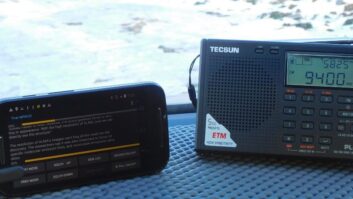Advocates say hundreds more are possible; NAB anticipates interference problems
WASHINGTON There’s a chance low-power FM radio stations may be allowed on third-adjacent channels after all. The FCC has said keeping the third-adjacent channel separation requirement is apparently no longer in the public interest; in a report to Congress it has recommended dropping the requirement.
A powerful lawmaker has signaled his intention to develop legislation to back up the report with action. LPFM groups believe “hundreds” more such frequencies may be allocated.
More than 3,000 organizations applied for LPFM licenses in 2000-02. An estimated 1,000 applications were granted, according to Deputy Chief of the FCC’s Audio Division Nina Shafran. Of those, about 300 are on the air.
Whether hundreds more LPFM frequencies would be allocated and how long this process might take is unknown. At least one radio observer believes that in this election year, the process from passage of legislation to FCC enactment could take a long time.
After reviewing a report of third-adjacent-channel testing conducted by Mitre Corp., the commission stated that “reduction or elimination of existing third-adjacent channel LPFM minimum distance separation requirements is possible without increasing the potential for third-adjacent channel LPFM interference to existing stations.”
Reacting to this unexpected setback, which came two months before its spring show, the NAB, long a vocal critic of LPFM, came out swinging against the FCC recommendation.
‘Deeply flawed’
NAB spokesman Dennis Wharton said, “It is unfortunate the FCC is relying on the deeply flawed Mitre study in making its recommendation to Congress. Local radio listeners should not be subjected to the inevitable interference that would result from shoehorning more stations onto an already overcrowded radio dial.”
“Despite near universal praise for low-power radio, incumbent broadcasters ‘cried wolf’ and successfully asked Congress to severely curtail the service in the most populated areas,” stated Cheryl Leanza, deputy director for Media Access Project.
LPFMs should be fully deployed, she said, calling NAB’s technical complaints about the Mitre report “a façade. … The broadcasters were never interested in the scientific truth in the first place.”
NAB, National Public Radio, the International Association of Audio Information Services and the Consumer Electronics Association raised questions about eliminating the interference protections.
Telecom attorney John Crigler of Garvey Schubert Barer said third-adjacent channel interference is a technical issue that has become a political issue, a thought echoed by more than one commenter to the commission.
Congress told the FCC to conduct the tests when it decided the commission should retain third-adjacent channel protections as LPFM was authorized in 2000.
Now, at least one lawmaker who voted against the Telecom Act is seeking to allow more low-powered stations on the air as a solution to media consolidation.
Senate Commerce Committee Chairman John McCain, R-Ariz., stated:, “Four years ago, broadcasters masqueraded their concern about competition from new low-power FM stations in grossly exaggerated claims of interference. The FCC has (now) stripped the broadcasters of this disguise by concluding that these stations would cause virtually no interference, and recommending the removal of certain limits on such stations.”
The Mitre report states that no third-adjacent channel interference between an LPFM and a full-service FM would exist beyond a 1.1 kilometer radius – about 3,600 feet – around the LPFM transmitter site. The existing complaint and license modification procedures should be enough to resolve any “anomalous” interference cases, believes the commission.
The FCC’s report also concludes that LPFMs on third-adjacents would have “little or no” effect on a terrestrial station’s transition to digital because third-adjacent channel LPFM interference to digital receivers is “unlikely” to occur beyond 130 meters – about 425 feet – from the LPFM transmitter.
In public comments filed by 24 parties, none addressed this issue, the commission stated. Eighteen commenters support eliminating or changing the third-adjacent channel minimum separation requirements.
Three filers, including Cox Radio, NAB and Livingston Radio, support retaining third-adjacent channel protections.
One set of ears?
“Mitre produced and compiled a voluminous report, but it did not have audiences judge whether objectionable and harmful interference occurred, and neither were its interference determinations based upon any manner of averaging,” stated Cox in its comments to the FCC.
“Instead, a single individual – indeed, a professional technician – offers the sole opinion for all of Mitre’s extensive interference determinations.”
Cox agreed with NAB and Livingston that the commission cannot reasonably rely on the report to recommend modifications to the separations requirements.
“Mitre has elevated the opinion of a sole professional above that of the average radio listener, and, more to the point, it unabashedly has elevated cost concerns above congressional mandate.”
Livingston Radio Co., licensee of Station WHMI, a Class A FM station in Howell, Mich., stated: “The (Mitre) report indicates that at the protected contour of a full-power FM station, a third-adjacent channel LPFM station would be expected to cause interference over a radius of 1.1 km around the LPFM transmitter, which equates to an area of about 3.8 square kilometers. … A third-adjacent LPFM station would in effect punch a ‘bullet hole’ of 3.8 sq. km. or less in the service area of a full-power station.”
Several new LPFM allocations would, in effect, create multiple “bullet holes” in a full-power FM’s service area, “leaving the full-power station with a service area looking like a slice of Swiss cheese,” states Livingston.
“The present rules do not take into account the cumulative impact of multiple LPFM stations. … The laws of physics apply at all power levels, not just high power; and they cannot be ignored just because LPFM stations operate at lower power than their full-power counterparts. Livingston fears that the commission is trying too hard to brush the laws of physics aside because of its public policy objective of increasing the number of media voices.”
Another three filers, including NPR and IAAIS, support keeping existing channel protections with respect to FMs providing reading services on their subcarriers.
Although NPR believes LPFMs could be placed on third-adjacents with certain restrictions, it took issue with the methodology of the FM subcarrier and radio reading service tests conducted by Comsearch, a Mitre subcontractor for the LPFM tests.
Comsearch tested only a single SCA receiver and only one radio reading service – on KNOW(FM) in Saint Paul, Minn. – “even though radio reading services operate on one of two subcarriers, and the full-power station at issue operates monaurally, making the reading service it carries less vulnerable to interference,” NPR stated.
“As a general matter, given obvious variances in terrain, station technical parameters and other variables among stations that carry radio reading services, it is impossible to draw conclusions about all radio reading services based on the results of a field test of a single one,” states NPR.
NPR said the Mitre study had “limited value” in determining “the likelihood and severity” of third-adjacent channel LPFM interference.
Interference complaint resolution
Further, NPR said if it does allow LPFMs on third-adjacents, the interference complaint resolution process should be expanded. The FCC “should consider complaints from listeners beyond 1 kilometer from the LPFM site, listeners whose reception via mobile receivers is impaired, listeners who complain more than 1 year after initiation of the LPFM service, and listeners whose reception of translator service is impaired.”
NPR said the FCC should not ignore complaints because the interference was not “predicted.”
Ten individual LPFM filers who favor dropping the third-channel protection requirements reported that their LPFMs are suffering co-channel interference that could be eliminated if the stations could change frequency to third-adjacent channels.
The commission is also asking Congress if it can skip what were supposed to be the last portions of the testing: listener tests and an economic analysis of the effects of LPFMs on existing FMs in a market due to the agency’s lack of funds. The commission estimates the additional testing would cost around $800,000.
LPFM supporters were pleased.
The Prometheus Radio Project says such a change could result in “hundreds” of new LPFMs on the air.
“Convinced by the corporations’ cries of ‘interference,’ Congress passed a law keeping low-power radio off of most of its intended frequencies, and over 60 percent of the potential stations were lost,” stated Prometheus Radio Project technical director Pete Tridish.
The group intends to help groups apply for LPFM stations.












